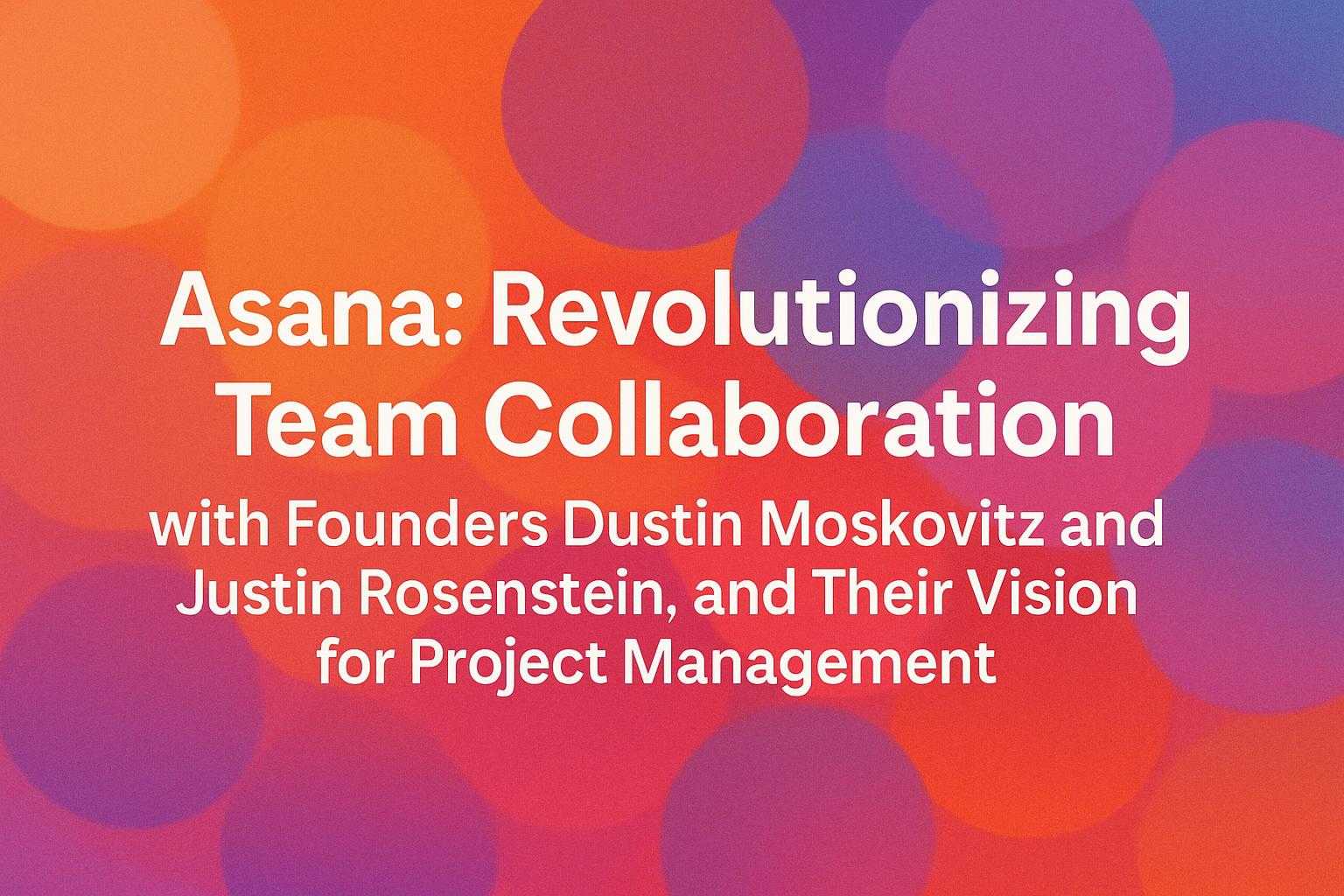Asana: Revolutionizing Team Collaboration with Founders Dustin Moskovitz and Justin Rosenstein, and Their Vision for Project Management.

Company profile
Company business details
Motivation to build the product
The founders of Asana were motivated by the need to improve team collaboration and productivity. They recognized that many teams struggled with clarity in project management and communication, which often led to inefficiencies and frustration. This insight sparked the idea to create a platform that would streamline work tracking and enhance team alignment.Problem that their product solves
Asana solves the problem of clarity and organization in project management. Its end users are teams and organizations that need to manage tasks and projects effectively. Solving this problem is important for these users as it helps them enhance productivity, reduce miscommunication, and achieve their goals more efficiently.Their unfair advantage
Asana's unfair advantage lies in its user-friendly interface and comprehensive features that cater specifically to the needs of teams, making it easier for them to collaborate and manage projects compared to traditional tools like email and spreadsheets.Strategies
Pre-Launch (Product Development & MVP)
Internal Tool Development
Dustin Moskovitz and his co-founder Justin Rosenstein began by solving collaboration problems within their own teams at Facebook. They built several internal tools, including a collaborative work management system, which they later recognized as a universal problem that could be addressed outside of Facebook. This led them to leave Facebook and start Asana, where they aimed to create a product that made collaboration effortless, drawing from their experiences with internal tools.
Mindfulness Training for Employees
Asana implemented mindfulness training for its employees to promote sustainable work habits. This included teaching employees about the importance of taking breaks, managing stress, and maintaining a work-life balance. By fostering a culture of mindfulness, Asana aimed to prevent burnout and encourage employees to develop healthy work patterns.
Launch Stage
Lean Startup Methodology
Asana's founders adopted Lean Startup methodology to ensure they focused on impactful work. They engaged with advisors to refine their approach, emphasizing the importance of leveraging their time and resources effectively. This methodology guided their product development and corporate culture, allowing them to build a company that prioritized long-term success over short-term gains.
Podcast Promotion
Tim Ferriss utilized his podcast, 'The Tim Ferriss Show', as a platform to promote his books and ideas. By interviewing high-profile guests and discussing various topics, he not only provided value to his audience but also created a buzz around his projects. This strategy helped him to establish authority in the self-improvement and entrepreneurship space, leading to increased book sales and audience growth.
Growth Stage
Employee-Centric Culture
Dustin emphasized the importance of creating an employee-centric culture at Asana. He implemented practices that fostered clear communication and expectations between employees and managers, which helped reduce conflict and increase engagement. By investing in the well-being of employees and ensuring they felt valued, Asana was able to maintain high levels of productivity and low attrition rates.
Community Engagement and Philanthropy
Dustin Moskovitz has been actively involved in philanthropy, particularly through Open Philanthropy, which he co-founded. This organization focuses on finding the most effective ways to do good, emphasizing the importance of long-term thinking and collaboration with other funders. By supporting impactful initiatives, Dustin aims to create a positive societal impact while also aligning with Asana's values of making work better for everyone.
Customer Base Expansion
Dustin Moskovitz announced that Asana had reached 20,000 customers, showcasing their growth in the SaaS collaboration market. This milestone was a result of their focus on work tracking, which helps teams clarify their goals and responsibilities. By emphasizing the importance of work tracking, Asana aimed to attract more knowledge workers, a market that consists of 500 million people worldwide who were not yet using any work tracking tools.
Diversity and Inclusion Initiatives
Dustin highlighted the importance of diversity and inclusion within Asana. They proactively worked on hiring practices to ensure a diverse workforce and implemented unconscious bias training. By focusing on diversity from the start, Asana aimed to create an inclusive environment that would attract underrepresented groups and foster a culture of belonging.
Engagement in Social Causes
Asana's leadership, including Dustin, actively engaged in social causes by donating significant amounts to various initiatives. They believed in the philosophy of giving early and effectively, which led to contributions of around $200 million to global health, development, and public policy issues. This commitment to social responsibility not only aligned with their company values but also helped to establish Asana as a leader in the tech community.
Flexible Work Environment
Asana adopted a flexible work environment that allowed employees to work in a way that suited their personal lives. They served dinner at 6:30 PM to accommodate those who stayed late but emphasized that it was culturally acceptable for employees to leave earlier. This approach aimed to promote a healthy work-life balance and prevent burnout among employees.
Hackathons with a Balanced Approach
Asana organized hackathons that were designed to foster creativity without compromising employee well-being. They offered hackathons during the day and across multiple days, allowing employees with different schedules to participate. This approach aimed to create bonding experiences while ensuring that intense work periods were not the norm.
5-Bullet Friday Newsletter
Tim Ferriss launched the '5-Bullet Friday' newsletter, which is a free weekly email that shares five interesting things he has found each week. This newsletter has grown to over 1.5 million subscribers, showcasing its effectiveness in building a loyal audience and engaging with them regularly. The newsletter includes a mix of personal insights, book recommendations, and tools, which helps to maintain a connection with his audience and keeps them engaged with his content.
No Meeting Wednesdays
Dustin Moskovitz implemented 'No Meeting Wednesdays' at Asana to allow employees uninterrupted time for deep work. This initiative was inspired by Paul Graham's essay on the 'Maker's Schedule, Manager's Schedule', emphasizing the need for long focus blocks for productivity. By synchronizing everyone's calendars to avoid meetings on Wednesdays, the company aimed to enhance individual productivity and encourage a culture of focused work.
AI Integration in Asana
Dustin Moskovitz is excited about integrating AI into Asana to enhance productivity. This includes features like a writing assistant to help draft tasks and summarize discussions, as well as proactive identification of open loops and key risks in projects. The goal is to create a system that not only assists users but also anticipates their needs, ultimately streamlining workflows and reducing the cognitive load on employees.
Maturity & Scaling
Conscious Leadership Practices
Asana incorporated conscious leadership practices into its corporate culture, focusing on non-violent communication and clarity around decision rights. This approach aimed to create a supportive environment where employees could thrive and collaborate effectively. By addressing the softer aspects of collaboration, Asana sought to enhance overall team dynamics and productivity.
Intentional Company Culture Building
From the very beginning, Asana's leadership was intentional about building a strong company culture. Dustin emphasized the importance of mindfulness in creating a positive work environment, which led to high employee engagement and satisfaction. They focused on reflective practices and iterated on their culture to ensure that employees were happy and productive, resulting in a perfect Glassdoor rating.
User's Guide for Team Management
Dustin Moskovitz created a comprehensive 'User's Guide' for his team at Asana, detailing his management style, communication preferences, and personal quirks. This guide was initially intended for his direct reports but was later expanded for the entire company. It serves as a tool for onboarding new employees and helps to foster a better understanding of team dynamics, ultimately improving collaboration and productivity.
Effective Altruism Funding
Dustin Moskovitz has been a significant funder of effective altruism initiatives, focusing on global health, animal welfare, and global catastrophic risks. By prioritizing neglected areas that can yield the most good, he aims to leverage his resources to address pressing global issues. This strategy not only aligns with his personal values but also enhances his reputation as a socially responsible entrepreneur.
Saturation & Retention
Building Trust and Reputation
Dustin believes in the importance of building trust with employees and customers as a core business strategy. He advocates for ethical practices that prioritize long-term relationships over short-term gains. By fostering a culture of integrity and transparency, Asana aims to create a sustainable business model that benefits all stakeholders, ultimately leading to a stronger reputation and customer loyalty.
Learn more about Asana

Lessons From Co-Founding Facebook, And Now Asana | Dustin Moskovitz

Dustin Moskovitz, Asana: Fast Growth, Mindful Business



